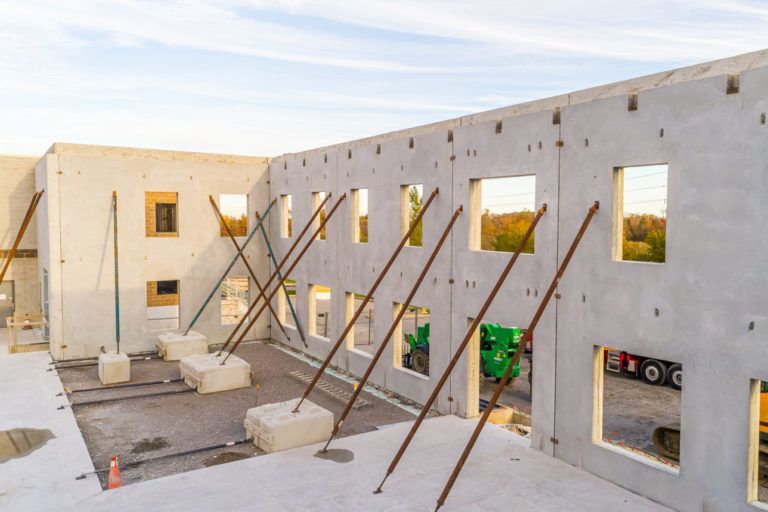Tilt-Up VS Masonry

There are many options when it comes to building a structure – masonry and tilt-up construction are two of them. Masonry is quite popular, and it has been around for centuries. Tilt-up has been around for more than 100 years and is growing in popularity each year. When comparing tilt-up with masonry, which one is right for your project?
The difference between masonry and tilt-up construction
Masonry is a tried and true construction method with a long history and a strong reputation. It involves building structures by laying individual masonry units and binding them together with cement mortar. The individual masonry units can be brick, concrete block, stone or other similar materials.
In contrast, tilt-up construction is a less labour-intensive method that involves forming and pouring concrete wall panels onsite, and then using a crane to lift them into place.
Both can result in beautiful buildings, each with their advantages, but they involve very different approaches.
Pros and cons of masonry construction
There are many benefits to using masonry for a construction project. First, it can be cost-effective. Masonry units have a naturally appealing look without applying external finishes, so once they’re installed, no further work is needed. This can lead to cost savings since additional materials aren’t needed, and special trades that apply finishes aren’t necessary.
Masonry is non-combustible and improves the safety of a building. This is why fireplaces are often built with masonry units. Additionally, masonry is highly resistant to pests and bad weather.
Masonry is also an effective way to give a home or building a classic, rustic look.
However, masonry has its downsides, too. Laying bricks can’t take place in rainy weather or freezing temperatures, as the cement mortar is vulnerable to these conditions. Masonry also performs poorly during some natural disasters, such as earthquakes. During construction, specialized manpower is required, and masonry can add a lot of time to a project schedule. Furthermore, masonry units are quite heavy, meaning manual labour is needed to get materials to the right place, and this excessive movement can increase carbon emissions for the project.
Pros and cons of tilt-up construction
Tilt-up construction has many positives. Tilt-up buildings can be erected on tight schedules, which result in lower construction costs. Tilt-up also follows a simplified construction process and doesn’t require as many specialty trades which results in cost savings.
Tilt-up buildings are durable and can withstand the impact of a wide range of weather events and natural disasters.
The thick concrete has thermal mass, which makes it easier to maintain the internal temperature of the building. This results in lower energy costs over time.
The concrete in tilt-up buildings naturally absorbs sound, which reduces noise pollution and makes the space more enjoyable for inhabitants. From a design standpoint, tilt-up wall exteriors also allow for more spacious buildings without using perimeter columns. And construction of tilt-up buildings can be safer than construction processes with other materials like wood.
All of that being said, there are a few cons of using tilt-up. Tilt-up construction may require higher upfront costs; however, these are offset by the building’s energy savings and longevity. Tilt-up construction also requires favourable weather conditions when casting the slabs. Lastly, construction on tilt-up buildings can be difficult on smaller sites, but with the right equipment and an experienced team, there are plenty of workarounds.
Choosing between tilt-up and masonry construction
When considering your building methods and materials, your decision ultimately depends on the factors that are most important. Your project timeframe, your location, your building usage, your budget and your design preferences should all be taken into consideration.
Ultimately, tilt-up construction is often the ideal choice. It has unmatched durability, cost-effectiveness, energy efficiency and architectural versatility. Even if you like the aesthetic appeal of masonry, this can be achieved with tilt-up form liners (e.g. thin brick, thin block.).
Get In Touch
Reach out to us to learn more about our capabilities or ask us a question.
Already have a specific project you’d like to discuss? Send us the details and a member of our team will be in touch!
